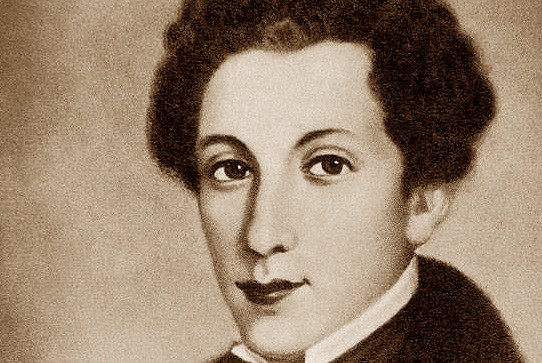
The brilliant musical career of composer Juan Crisóstomo Arriaga, dubbed the “Spanish Mozart” by later musicians was tragically cut short. Rejoicing in the name of Juan Crisóstomo Jacobo Antonio de Arriaga y Balzola, he was born in Bilbao where his father and brother had strong connections with the Madrid court. And it’s true that Arriaga had much in common with Mozart. For a start, he was born on 27th January and the same date as Mozart, though exactly fifty years later. They also shared the first and second baptismal names.
Like Mozart, Arriaga played the piano and violin and was first taught by his father. He proved to be a child prodigy and “an excellent and intuitive musician” whose earliest compositions included the divertimento Nada y mucho composed at the age of eleven and a two-act opera Los Esclavos Felices written when he was thirteen and first performed in Bilbao to great acclaim. And sadly, like Mozart he was destined to die young.
When he was fifteen Arriaga went to Paris to study and met Luigi Cherubini, who for a time was an examiner at the Paris Conservatoire. He was admitted to study theory and composition and while there composed three string quartets, some piano pieces, choral music and his one symphony. Arriaga soon became a teaching assistant at the Conservatoire and was well known for his extraordinary talent. Cherubini referred to Arriaga’s fugue for eight voices simply as “a masterpiece”.
What impressed all his teachers was the young man’s ability to use musically sophisticated harmonies, counterpoint, and related techniques without ever being taught them. It’s possible that the intensity of his work at the Paris Conservatoire may have taken a toll on his health. Just ten days before his twentieth birthday, Arriaga died of a lung condition probably complicated by physical and mental exhaustion.
Arriaga’s early death was not only a loss to Spanish music but to European music as a whole. Along with his string quartets, this symphony is Arriaga’s most important work. If you didn’t know, you’d probably guess that it might be an early symphony of Schubert, who was only nine years older than Arriaga.
The symphony is written in the usual four movements but drifts between D major and D minor so frequently that it’s not really in either key. The slow introduction sounds almost Mozartian. But not for long. The ensuing fast section seems to leave the eighteenth century far behind. There are some imaginative and effective twists of harmony and between the lyrical melodies, Arriaga creates some dramatic moments.
In the second movement (at 10:20) the young composer writes lovely lyrical expansive melodies, one of which sounds vaguely similar to the hymn All Things Bright and Beautiful. The minuet is strikingly original with beautifully transparent scoring in the waltz-like trio. It has a delightful and original ending too.
At times, the final movement (at 23:05) seems to echo Rossini, whose opera The Barber of Seville had been given its premiere when Arriaga was ten years old. But although there are reflections of Schubert and Rossini in this extraordinary work, the musical language is entirely Arriaga’s own. One can’t help wondering what he would have brought to music had he not been taken away so early in his life.
Mozart was eighteen and the same age as Arriaga when he wrote his Symphony in D in 1774. But there was a difference, because Mozart already had a couple of dozen symphonies behind him. We don’t know exactly how many because some early Mozart symphonies are of doubtful authenticity. For example, Symphony No. 2 was almost certainly written by his father and Symphony No 3 was written by Carl Friedrich Abel. But the young Mozart wasn’t cheating. The eight-year-old Mozart had merely copied out Abel’s symphony for study purposes when he visited London in 1764 and publishers later assumed it was his own work.
Symphony No 30 is cast in the usual four movements and kicks off with a confident fanfare-like figure for the full orchestra, later making much use of dynamic contrast and answering phrases. The delicate second movement (at 06:39) shows Mozart’s increasingly sophisticated writing. The minuet and trio are anything but dance-like and display a wealth of invention with many answering phrases and sudden dynamic contrasts. The opening notes of the playful and charming last movement look back briefly to the beginning of the symphony while the closing bars of the work come as a complete surprise. Even as a teenager, Mozart could be so unpredictable.
 |
 |
 |





